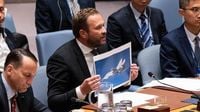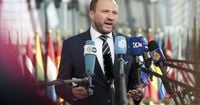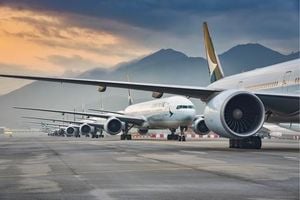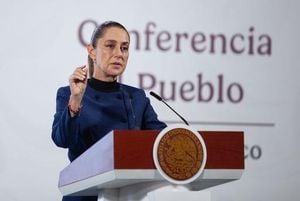Estonia found itself at the center of a growing storm between NATO and Russia last week, after three Russian MiG-31 fighter jets violated its airspace for a tense 12 minutes near Vaindloo Island in the Gulf of Finland. The incursion, which occurred on September 19, 2025, triggered a swift and coordinated response from both the Estonian government and the broader NATO alliance, highlighting the escalating security challenges facing Europe’s eastern flank.
According to Estonian officials, the Russian jets entered the country’s airspace without flight plans, with their transponders switched off and no two-way radio communication with Estonian air traffic control. The jets lingered over the Gulf of Finland, prompting the rapid deployment of Italian Air Force F-35s—currently stationed in the region as part of NATO’s Baltic Air Policing Mission. The NATO fighters intercepted the Russian aircraft, forcing them to retreat.
Prime Minister Kristen Michal wasted no time in condemning the violation, labeling it “totally unacceptable” in a statement on X. Foreign Minister Margus Tsahkna added that the jets were “carrying missiles and were combat-ready,” and described the breach as “crystal clear evidence of a breach of sovereignty,” according to Reuters. Tsahkna further noted that this was the fourth such incursion by Russian aircraft into Estonian airspace in 2025, but emphasized that “today’s incursion, involving three fighter jets entering our airspace, is unprecedentedly brazen.”
In response, Estonia summoned the Russian charge d’affaires and delivered a formal protest note. But the government didn’t stop there. Estonia invoked Article 4 of NATO’s founding treaty—a rarely used provision that allows any member state to call consultations when it perceives a threat to its territorial integrity, political independence, or security. As NATO spokesperson Allison Hart explained, the North Atlantic Council (NAC), the alliance’s main political decision-making body, was scheduled to convene early the following week to discuss the incident in detail, characterizing the event as “reckless Russian behaviour.”
The invocation of Article 4 is a significant diplomatic step. As noted by the Associated Press, it marked only the ninth time in NATO’s 76-year history that the article had been used, and the second time in September 2025 alone—following a separate incident involving Russian drones in Poland. The pattern is troubling: Estonia is now the third NATO country to report such an airspace violation in recent weeks, after similar incidents in Poland and Romania.
Poland’s experience was particularly alarming. On September 10, at least 20 Russian drones entered Polish airspace before being shot down by the military. This made Poland the first NATO country to directly engage Russian assets since Moscow’s full-scale invasion of Ukraine in 2022. Polish Foreign Minister Radosław Sikorski called the incursion “intentional,” and Polish Prime Minister Donald Tusk later warned at an emergency U.N. Security Council meeting, “We will make a decision to shoot down flying objects without discussion when they violate our territory and fly over Poland. There is no room for debate here.”
European leaders were quick to rally behind Estonia. EU foreign policy chief Kaja Kallas called the incident “an extremely dangerous provocation,” while European Commission President Ursula von der Leyen declared, “Europe stands with Estonia in the face of Russia’s latest violation of our airspace.” Von der Leyen also urged EU member states to approve a 19th sanctions package against Moscow, signaling the bloc’s readiness to escalate economic pressure.
Across the Channel, British Foreign Secretary Yvette Cooper described the Russian actions as “dangerous and reckless,” pledging that the UK was “ready to take all steps necessary to defend NATO skies and territory.” The message from NATO leadership was equally unambiguous. Secretary General Mark Rutte told reporters, “We are a defensive alliance, yes, but we are not naive. If it is not intentional, then it is blatantly incompetent.” Rutte stressed that while the Russian jets were not shot down because they posed no immediate threat, NATO commanders have the authority to “take the ultimate decision” if intruding aircraft are deemed dangerous.
The United States weighed in as well. President Donald Trump, speaking to reporters after the incident, remarked, “I don’t love it. I don’t like when that happens. It could be big trouble, but I’ll let you know later.” Later, during a meeting with Ukrainian President Volodymyr Zelensky at the U.N. General Assembly, Trump went further, saying NATO countries should shoot down Russian aircraft that violate their airspace—answering “yes” when asked directly, without offering qualifiers. This stance was notably more hawkish than that of NATO’s Secretary General, who emphasized the need for careful assessment before any shoot-down.
Meanwhile, Russia categorically denied the allegations. Kremlin spokesman Dmitry Peskov dismissed Estonia’s claims as “unfounded” and accused the country of escalating tensions. Peskov argued, “That is why we consider such words to be empty, unfounded and a continuation of a completely reckless pattern of escalating tensions and provoking a confrontational atmosphere.” The Russian Defence Ministry echoed this, insisting that its pilots always operate according to international law. Regarding the Polish drone incident, Russia maintained that its drones were targeting military facilities in Ukraine and had not been meant for Polish airspace.
But the tension isn’t limited to the Baltic region. Recent weeks have seen a spate of drone sightings that forced temporary closures of the main airports in Copenhagen and Oslo. Danish Prime Minister Mette Frederiksen called the incident the “most serious attack so far” on Denmark’s infrastructure, and said it could not be ruled out that Russia was involved, according to The New York Times.
Amid these mounting security concerns, NATO allies have vowed to strengthen their defenses along the alliance’s eastern flank. As NATO chief Mark Rutte put it, this is “crucial to counter aggression and defend every member of the Alliance.” The message is clear: the alliance is determined to deter further incursions—by military and non-military means—and to act “in the manner, timing, and domain of our choosing,” as NATO’s official statement warned.
The broader context, of course, is the ongoing war in Ukraine. As the head of the UK’s MI6 intelligence agency, Richard Moore, observed, “There is no evidence” that Russian President Vladimir Putin is interested in peace. “Putin has sought to convince the world that Russian victory is inevitable. But he lies. He lies to the world. He lies to his people. Perhaps he even lies to himself.” Ukraine, for its part, has repeatedly called for joint protection of European skies and increased investment in domestic weapons production to ward off Russian attacks.
The events in Estonia, Poland, and beyond are stark reminders that Europe’s security environment remains volatile. Each new incursion tests the resolve, unity, and readiness of NATO—and raises the stakes for all parties involved.






